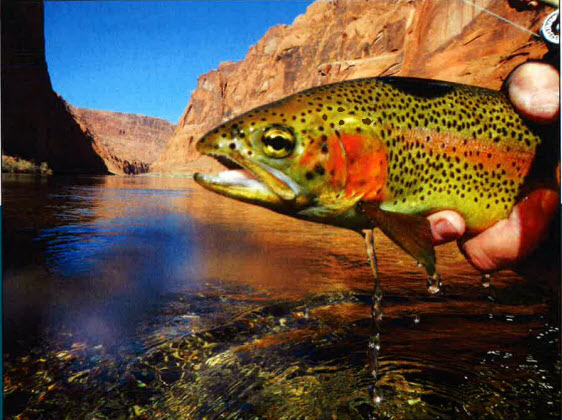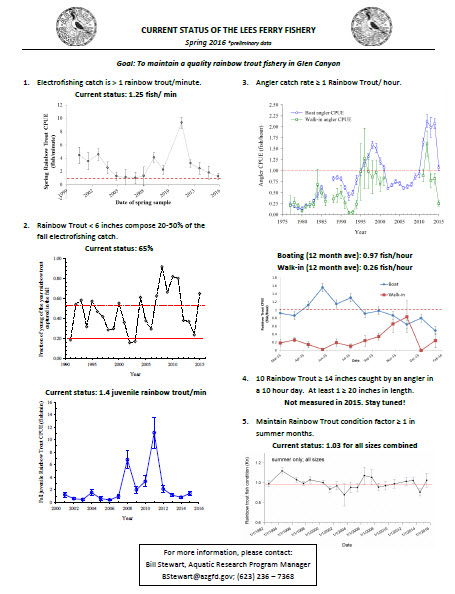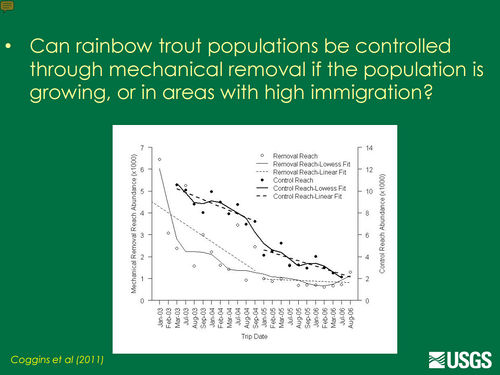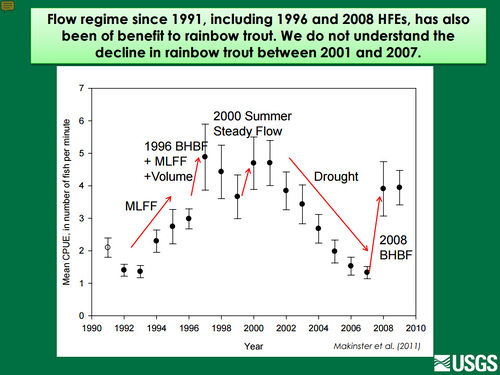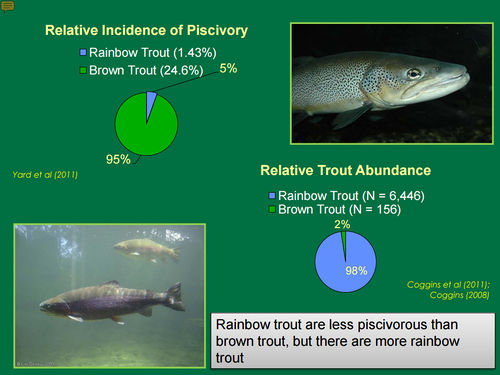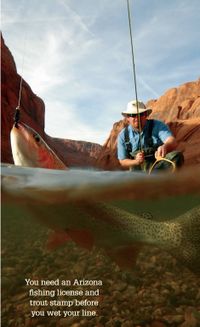Difference between revisions of "FISHERY"
Cellsworth (Talk | contribs) |
Cellsworth (Talk | contribs) |
||
| Line 22: | Line 22: | ||
------------Portal list on righthand side----------> | ------------Portal list on righthand side----------> | ||
|style="width:60%; font-size:120%;"| | |style="width:60%; font-size:120%;"| | ||
| + | |||
In 1964, the Lees Ferry tailrace on the Colorado River was given birth by the completion of Glen Canyon Dam, which impounded Lake Powell. Subsequent water releases from the bottom of Lake Powell changed the once highly turbid, warm waters of the Colorado River into a constant cold (46-50°F), clear flowing river. Shortly after completion of the dam, the Arizona Game and Fish Department stocked rainbow trout (Oncorhynchus mykiss) in the 15-mile Lees Ferry reach and, in 1981, began to manage this section of river as a Blue Ribbon trout fishery. The trout began to flourish in the Lees Ferry reach from 1970-1985 when catches of rainbow trout above 10-pounds were not uncommon, and angler pressure was relatively low. In 1991, however, the Bureau of Reclamation implemented the Record of Decision flow regime, which consisted of higher minimum and more stable flows and allowed for increased trout reproduction and survival. Under these conditions, a huge population of trout developed causing individual fish growth rates to decline. Quite simply, there was a large number of fish competing for limited space and food items, resulting in a fishery where trout less than 14-in were dominant. | In 1964, the Lees Ferry tailrace on the Colorado River was given birth by the completion of Glen Canyon Dam, which impounded Lake Powell. Subsequent water releases from the bottom of Lake Powell changed the once highly turbid, warm waters of the Colorado River into a constant cold (46-50°F), clear flowing river. Shortly after completion of the dam, the Arizona Game and Fish Department stocked rainbow trout (Oncorhynchus mykiss) in the 15-mile Lees Ferry reach and, in 1981, began to manage this section of river as a Blue Ribbon trout fishery. The trout began to flourish in the Lees Ferry reach from 1970-1985 when catches of rainbow trout above 10-pounds were not uncommon, and angler pressure was relatively low. In 1991, however, the Bureau of Reclamation implemented the Record of Decision flow regime, which consisted of higher minimum and more stable flows and allowed for increased trout reproduction and survival. Under these conditions, a huge population of trout developed causing individual fish growth rates to decline. Quite simply, there was a large number of fish competing for limited space and food items, resulting in a fishery where trout less than 14-in were dominant. | ||
In 2000, the [http://www.azgfd.gov/w_c/research_managing_lees_ferry.shtml| Arizona Game and Fish Department] began a long-term monitoring program sponsored by [http://www.gcmrc.gov/| Grand Canyon Monitoring and Research Center] to determine the effects of Glen Canyon Dam operation on the trout fishery at Lees Ferry and to make recommendations for improving this fishery. Since 2000, our data collection has shown an increase in the general health of all trout age classes (especially since 2002). This increase in fish health is usually associated with an increase in growth rates. There has been a marked increase in catch rates of young-of-the-year fish in recent years. With successful spawning and recruitment continuing to occur, fishing conditions in Lees Ferry are improving. | In 2000, the [http://www.azgfd.gov/w_c/research_managing_lees_ferry.shtml| Arizona Game and Fish Department] began a long-term monitoring program sponsored by [http://www.gcmrc.gov/| Grand Canyon Monitoring and Research Center] to determine the effects of Glen Canyon Dam operation on the trout fishery at Lees Ferry and to make recommendations for improving this fishery. Since 2000, our data collection has shown an increase in the general health of all trout age classes (especially since 2002). This increase in fish health is usually associated with an increase in growth rates. There has been a marked increase in catch rates of young-of-the-year fish in recent years. With successful spawning and recruitment continuing to occur, fishing conditions in Lees Ferry are improving. | ||
| − | |||
| − | |||
|}<!-- | |}<!-- | ||
| Line 32: | Line 31: | ||
----------Strapline immediately below banner----------> | ----------Strapline immediately below banner----------> | ||
{| style="width:100%; height:50px" border=1px solid #ccc; background:#cedff2 | {| style="width:100%; height:50px" border=1px solid #ccc; background:#cedff2 | ||
| − | ! style="width= | + | ! style="width=50%; background:#cedff2;" | [[File:RainbowTrout1.jpg]]<br> [http://www.azgfd.gov/h_f/fish_rainbow_trout.shtml Rainbow Trout] |
| − | ! style="width= | + | ! style="width=50%; background:#cedff2;" | [[File:BrownTrout1.jpg]]<br> [http://www.azgfd.gov/h_f/fish_brown_trout.shtml Brown Trout] |
| − | + | ||
|} | |} | ||
| Line 81: | Line 79: | ||
|- | |- | ||
|style="color:#000;"| | |style="color:#000;"| | ||
| + | *[http://www.azgfd.gov/w_c/research_managing_lees_ferry.shtml Managing for Blue Ribbon Rainbow Trout at Lee's Ferry] | ||
*[https://drive.google.com/file/d/0BwY-Z2c3NTUGUmxPbko2dm9URms/view Lees Ferry Anglers Trout Fishery Recommendations] | *[https://drive.google.com/file/d/0BwY-Z2c3NTUGUmxPbko2dm9URms/view Lees Ferry Anglers Trout Fishery Recommendations] | ||
*[https://drive.google.com/file/d/0BwY-Z2c3NTUGWVJmckxIUXdhMU0/view State of Arizona Lees Ferry Fish Management Plan] | *[https://drive.google.com/file/d/0BwY-Z2c3NTUGWVJmckxIUXdhMU0/view State of Arizona Lees Ferry Fish Management Plan] | ||
| Line 152: | Line 151: | ||
|- | |- | ||
|style="color:#000;"| | |style="color:#000;"| | ||
| − | |||
| − | |||
| − | |||
| − | |||
[[Image:Vermillion Video- Fishing.jpg|thumb|300px]]<br>'''[http://vimeo.com/76818138 Vermillion: Highlights the passion the fishing community has for the Glen Canyon fishery and their love of not only the fishing experience but for the TOTAL experience. VIDEO LINK]''' | [[Image:Vermillion Video- Fishing.jpg|thumb|300px]]<br>'''[http://vimeo.com/76818138 Vermillion: Highlights the passion the fishing community has for the Glen Canyon fishery and their love of not only the fishing experience but for the TOTAL experience. VIDEO LINK]''' | ||
Revision as of 15:21, 26 July 2016
|
|
In 1964, the Lees Ferry tailrace on the Colorado River was given birth by the completion of Glen Canyon Dam, which impounded Lake Powell. Subsequent water releases from the bottom of Lake Powell changed the once highly turbid, warm waters of the Colorado River into a constant cold (46-50°F), clear flowing river. Shortly after completion of the dam, the Arizona Game and Fish Department stocked rainbow trout (Oncorhynchus mykiss) in the 15-mile Lees Ferry reach and, in 1981, began to manage this section of river as a Blue Ribbon trout fishery. The trout began to flourish in the Lees Ferry reach from 1970-1985 when catches of rainbow trout above 10-pounds were not uncommon, and angler pressure was relatively low. In 1991, however, the Bureau of Reclamation implemented the Record of Decision flow regime, which consisted of higher minimum and more stable flows and allowed for increased trout reproduction and survival. Under these conditions, a huge population of trout developed causing individual fish growth rates to decline. Quite simply, there was a large number of fish competing for limited space and food items, resulting in a fishery where trout less than 14-in were dominant. In 2000, the Arizona Game and Fish Department began a long-term monitoring program sponsored by Grand Canyon Monitoring and Research Center to determine the effects of Glen Canyon Dam operation on the trout fishery at Lees Ferry and to make recommendations for improving this fishery. Since 2000, our data collection has shown an increase in the general health of all trout age classes (especially since 2002). This increase in fish health is usually associated with an increase in growth rates. There has been a marked increase in catch rates of young-of-the-year fish in recent years. With successful spawning and recruitment continuing to occur, fishing conditions in Lees Ferry are improving. |
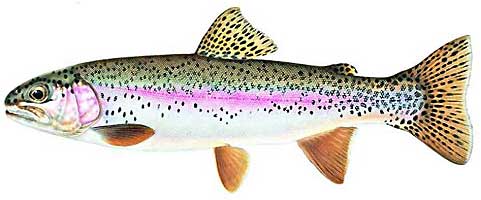 Rainbow Trout |
 Brown Trout |
|---|
HISTORY
|
Additional Links
|
